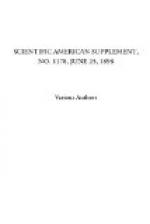We may well here summarize these other changes in function:
(1) The respiratory movement becomes shallow and thoracic in type.
(2) The volume of the air inspired per minute is lessened by one-half to two-thirds.
(3) The output of carbonic acid is diminished by the same amount.
(4) The bodily temperature falls.
(5) The acidity of the cortex of the brain disappears.
(6) Reflex action persists; the knee jerk is diminished, pointing to relaxation in tone of the muscles; consciousness is suspended.
Analyzing more closely the conditions of the central nervous system, it becomes evident that, in sleep, consciousness alone is in abeyance. The nerves and the special senses continue to transmit impulses and to produce reflex movements. If a blanket, sufficiently heavy to impede respiration, be placed upon the face of a sleeping person, we know that it will be immediately pushed away. More than this, complicated movements can be carried out; the postilion can sleep on horseback; the punkah-wallah may work his punkah and at the same time enjoy a slumber; a weary mother may sleep, and yet automatically rock her infant’s cradle. Turning to the histories of sleep walkers, we find it recorded that, during sleep, they perform such feats as climbing slanting roofs or walking across dangerous narrow ledges and bridges. The writer knew of the case of a lad who, when locked in his room at night to prevent his wandering in his sleep, climbed a partition eight to ten feet in height which separated his sleeping compartment from the next, and this without waking.
The brain can carry out not only such complicated acts as these, but it has been found to maintain during sleep its normal inhibitory control over the lower reflex centers in the spinal cord.
Thus, in sleeping dogs, after the spinal cord has been divided in the dorsal region, reflexes can be more easily evoked from the lumbar than from the cervical cord, because the former is freed from the inhibitory control of the brain.
The strength of stimulus necessary to pass the threshold of consciousness and to produce an awakening has been measured in various ways. It has been determined that it takes a louder and louder sound or a stronger and stronger electric shock to arouse a sleeper during the first two or three hours of slumber; after that period, the sleep becomes lighter and the required stimulus need be much less.
The alternative theories which have been suggested to account for the onset of sleep may be classed as chemical and histological.




